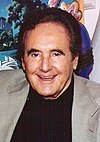Portal:Cartoon
The Cartoon Portal

A cartoon is a type of visual art that is typically drawn, frequently animated, in an unrealistic or semi-realistic style. The specific meaning has evolved, but the modern usage usually refers to either: an image or series of images intended for satire, caricature, or humor; or a motion picture that relies on a sequence of illustrations for its animation. Someone who creates cartoons in the first sense is called a cartoonist, and in the second sense they are usually called an animator.
The concept originated in the Middle Ages, and first described a preparatory drawing for a piece of art, such as a painting, fresco, tapestry, or stained glass window. In the 19th century, beginning in Punch magazine in 1843, cartoon came to refer – ironically at first – to humorous artworks in magazines and newspapers. Then it also was used for political cartoons and comic strips. When the medium developed, in the early 20th century, it began to refer to animated films that resembled print cartoons. (Full article...)

In print media, a cartoon is a drawing or series of drawings, usually humorous in intent. This usage dates from 1843, when Punch magazine applied the term to satirical drawings in its pages,[1] particularly sketches by John Leech.[2] The first of these parodied the preparatory cartoons for grand historical frescoes in the then-new Palace of Westminster in London.[3]

Selected article -
Eagle was a seminal British children's comic, first published in April 1950. It was founded by Marcus Morris, an Anglican vicar, who felt that the church was not communicating its message effectively. Simultaneously disillusioned with contemporary children's literature, he and artist Frank Hampson created a dummy comic based on Christian values. Morris hawked the idea to several publishers, with little success, until Hulton Press decided to take it on. Following a huge publicity campaign, the first issue sold about 900,000 copies. Featured in colour on the front cover was the comic's most recognisable story, Dan Dare, Pilot of the Future (pictured). Other popular stories included Riders of the Range and P.C. 49. Eagle also contained news and sport sections, and educational cutaway diagrams of sophisticated machinery. Amidst a takeover of the comic's publisher and a series of acrimonious disputes, Morris left in 1959; Hampson followed shortly thereafter. Although Eagle continued in various forms, a perceived lowering of editorial standards preceded plummeting sales, and it was eventually subsumed by its rival, Lion, in 1969. A relaunched Eagle ran for over 500 issues between 1982 and 1994.
Selected character -
Bart Simpson is a fictional main character in the animated television series The Simpsons and part of the eponymous family. He is voiced by actress Nancy Cartwright and first appeared on television in The Tracey Ullman Show short "Good Night" on April 19, 1987. Bart was created and designed by cartoonist Matt Groening while he was waiting in the lobby of James L. Brooks' office. While the rest of the characters were named after Groening's family members, Bart's name was an anagram of the word brat. After appearing on The Tracey Ullman Show for three years, the Simpson family received their own series on Fox, which debuted December 17, 1989. He has appeared in other media relating to The Simpsons; including video games, The Simpsons Movie, The Simpsons Ride, commercials, and comic books; and inspired an entire line of merchandise. Hallmarks of the character include his chalkboard gags in the opening sequence; his prank calls to Moe the bartender; and his catchphrases "Eat my shorts", "¡Ay, caramba!", and "Don't have a cow, man!" Nancy Cartwright has won several awards for voicing Bart, including a Primetime Emmy Award in 1992 and an Annie Award in 1995. In 2000, Bart, along with the rest of his family, was awarded a star on the Hollywood Walk of Fame.
Did you know... -
- ...that William Hanna claimed that the Tom and Jerry character Jerry Mouse was named Jinx in his first appearance while Joseph Barbera claimed that the mouse went nameless?
- ...that the Simpsons short Good Night aired April 19, 1987 on The Tracey Ullman Show and was the first ever appearance of the Simpson family on television?
- ...that Uri-On, created by Michael Netzer in 1987, was the first Israeli superhero to be published in color?
- ...that Ed, Edd n Eddy's TV movie series finale, Ed, Edd n Eddy's Big Picture Show, premiered on November 8, 2009, and achieved high ratings success for Cartoon Network?
Selected list -
The Hugo Award for Best Graphic Story is given each year for science fiction or fantasy stories told in graphic form and published in English or translated into English during the previous calendar year. The Hugo Award for Best Graphic Story has been awarded annually since 2009. It was started then with the requirement that it would only continue as an official award if approved again by the World Science Fiction Society after that year. It was, and was again awarded in 2010; it will need to be ratified again after the 2012 awards in order to continue. Hugo Award nominees and winners are chosen by supporting or attending members of the annual World Science Fiction Convention, or Worldcon, and the presentation evening constitutes its central event. The selection process is defined in the World Science Fiction Society Constitution as instant-runoff voting with five nominees, except in the case of a tie as happened in 2009. In the four years that the award has been active, twenty-one works from twelve series have been nominated. Girl Genius, written by Kaja and Phil Foglio, drawn by Phil Foglio, and colored by Cheyenne Wright, won the first three awards.
General images -
-
Cecil Rhodes, as The Rhodes Colossus, wishes for a railway stretching across Africa from the Cape of Good Hope to Egypt. (from Political cartoon)
-
1899 cartoon showing Uncle Sam lecturing four children labeled Philippines, Hawaii, Puerto Rico, and Cuba. The caption reads: "School Begins. Uncle Sam (to his new class in Civilization)!" (from Political cartoon)
-
U.S. President Theodore Roosevelt introduces Taft as his crown prince: Puck magazine cover, 1906. (from Political cartoon)
-
Example of a modern cartoon. The text was excerpted by cartoonist Greg Williams from the Wikipedia article on Dr. Seuss.
-
John Leech, Substance and Shadow (1843), published as Cartoon, No. 1 in Punch, the first use of the word cartoon to refer to a satirical drawing (from Cartoon)
-
1903 political cartoon. The U.S.'s intentions to influence the area (especially the Panama Canal construction and control) led to the separation of Panama from Colombia. (from Political cartoon)
-
A cartoon map of Europe in 1914, at the beginning of World War I. (from Political cartoon)
-
A Rake's Progress, Plate 8, 1735, and retouched by William Hogarth in 1763 by adding the Britannia emblem. (from Political cartoon)
-
1942 political cartoon by Dr. Seuss (from Political cartoon)
-
Nast depicts the Tweed Ring: "Who stole the people's money?" / "'Twas him."
-
James Gillray's The Plumb-pudding in Danger (1805). The world being carved up into spheres of influence between Pitt and Napoleon. According to Martin Rowson, it is "probably the most famous political cartoon of all time—it has been stolen over and over and over again by cartoonists ever since." (from Political cartoon)
-
Benjamin Franklin's Join, or Die (May 9, 1754), credited as the first cartoon published in an American newspaper (from Cartoonist)
-
An editorial cartoon of Andrew Johnson and Abraham Lincoln, 1865, entitled The Rail Splitter at Work Repairing the Union. The caption reads: (Johnson): "Take it quietly Uncle Abe and I will draw it closer than ever." (Lincoln): "A few more stitches Andy and the good old Union will be mended." (from Political cartoon)
-
Stop-motion animated character from 20 Million Miles to Earth (1957). (from Animator)
-
Thomas Nast depicts the Tweed Ring: "Who stole the people's money?" / "'Twas him." (from Political cartoon)
Selected biography -
Joseph Barbera (1911–2006) was an influential American animator, film director, film producer, storyboard artist, and cartoon artist. Born in New York City, after working odd jobs and as a banker, Barbera joined Van Beuren Studios in 1932 and subsequently Terrytoons in 1936. He met his lifelong collaborator William Hanna while working for Metro-Goldwyn-Mayer in 1937 and soon began producing animated shorts such as the Tom and Jerry series. In 1957, after MGM dissolved their animation department, they co-founded Hanna-Barbera, which became the most successful television animation studio in the business, producing programs such as The Flintstones, The Huckleberry Hound Show, Top Cat, The Jetsons, Scooby-Doo, The Quick Draw McGraw Show, The Smurfs, Wacky Races and Yogi Bear. Hanna and Barbera won seven Academy Awards and eight Emmy Awards. Their shows, which have translations in more than 20 languages, had a global audience in the 1960s of over 300 million people.
Subcategories
WikiProjects
- Main projects
- Arts • Animation • Comics • Entertainment • Visual arts
- Related Projects
- Anime and manga • Biography • Film • Fictional characters • Media franchises • Music • Television • Video games
Selected quote -
Topics
- Comic book
- Comic strip
- Digital comics
- Graphic novel
- Mobile comic
- Motion comics
- Trade paperback
- Webcomic
- Animator
- Animation director
- Animation studios
- Animation film festivals
- Feature-length films
- Short films
- Television series
- Computer-animated films
- Stop-motion films
- Traditional animation
- Limited animation
- Rotoscoping
- Stop Motion
- Clay
- Cutout
- Graphic
- Model
- Object
- Pixilation
- Puppetoon
- Computer animation
- Flash animation
- PowerPoint animation
- SVG animation
- Cel-shaded animation
- Crowd simulation
- Morph target animation
- Motion capture
- Non-photorealistic rendering
- Skeletal animation
Things you can do

- Requested articles: Fenwick (comics), Khimaera (comics), Mutant Underground Support Engine, Bruce J. Hawker, Marc Dacier, Hultrasson, Frankenstein Comics, Dave Johnson (comics), Paco Medina, Dappere Dodo, New Adventures of the Space Explorers, Habatales, Musical Box, Foo-Foo (TV series), Bonne nuit les petits, The Adventures of Lariat Sam, More...
- Images and photos needed: Request images that are needed from Wikipedia requested images of comics and animation to included in each articles.
- Stubs: Work on stubs in articles in Comics and Animation stubs.
- Infobox: Add infobox that are needed from Category:Comics articles without infoboxes and Category:Animation articles needing infoboxes in articles.
- Deletion sorting: Please see the collection of discussions on the deletion of articles related to comics and animation - compiled by WikiProject Deletion sorting
Related portals
Associated Wikimedia
The following Wikimedia Foundation sister projects provide more on this subject:
-
Commons
Free media repository -
Wikibooks
Free textbooks and manuals -
Wikidata
Free knowledge base -
Wikinews
Free-content news -
Wikiquote
Collection of quotations -
Wikisource
Free-content library -
Wikiversity
Free learning tools -
Wiktionary
Dictionary and thesaurus
More portals
Sources
- ^ Punch.co.uk. "History of the Cartoon". Archived from the original on 2007-11-11. Retrieved 2007-11-01.
- ^ Adler & Hill 2008, p. 30.
- ^ "Substance and Shadow: Original Editorial Accompanying "Cartoon, No. I"". Victorian web.org. Retrieved 29 October 2023.









































